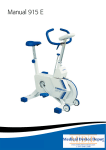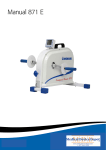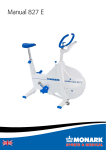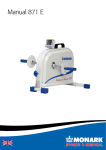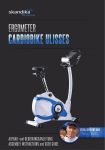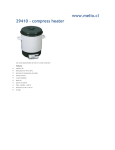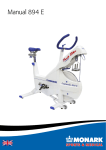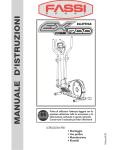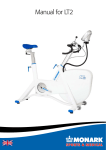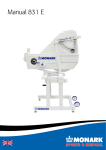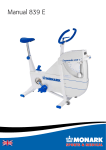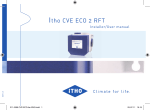Download Manual for 928 E
Transcript
Manual for 928 E Contents Monark Exercise AB ��������������������������������������� 4 Product Information ��������������������������������������� 5 Facts��������������������������������������������������������������������� 5 Serial number�������������������������������������������������������� 5 Operating Instruction ������������������������������������� 6 Workload adjustment�������������������������������������������� 6 Power measurement��������������������������������������������� 6 Cycle adjustments������������������������������������������������� 6 Power Connection������������������������������������������������� 6 Connection to an external unit������������������������������ 6 Meter instructions�������������������������������������������������� 7 Basic settings ������������������������������������������������������� 8 METS�������������������������������������������������������������������� 8 View of brake unit������������������������������������������������� 9 Calibration������������������������������������������������������������� 9 Personal settings������������������������������������������������ 10 Heart rate ����������������������������������������������������������� 11 Åstrand's fitness test������������������������������������������� 12 YMCA fitness test������������������������������������������������ 12 Manual training��������������������������������������������������� 13 Calories��������������������������������������������������������������� 13 Scale - zero adjustment�������������������������������������� 13 Mechanical calibration���������������������������������������� 14 Electronic calibration������������������������������������������� 14 Trouble shooting guide �������������������������������� 15 Service ����������������������������������������������������������� 16 Warning��������������������������������������������������������������� 16 Warranty������������������������������������������������������������� 16 Service check and Maintenance������������������������� 16 Batteries�������������������������������������������������������������� 17 Flywheel bearing������������������������������������������������� 17 Flywheel bearing������������������������������������������������� 17 Transportation����������������������������������������������������� 17 Replacement of brake belt���������������������������������� 17 Brake belt contact surface���������������������������������� 17 Chain 1/2“ x 1/8“������������������������������������������������� 18 Freewheel sprocket��������������������������������������������� 19 Spare parts list ��������������������������������������������� 20 Important Read the manual carefully before using the cycle and save it for future use. 2013 MONARK EXERCISE AB, Vansbro, Sweden Monark Exercise AB Monark has 100 years’ experience of bicycle production. The Monark tradition has yielded know-how, experience, and a real feel for the product and quality. Since the early 1900s, Monark’s cycles have been living proof of precision, reliability, strength and service. Those are the reasons why we are now the world leader in cycle ergometers and the market leader in Scandinavia in transport cycles. We manufacture, develop and market ergometers and exercise bikes, transport bikes and specialized bicycles. Our largest customer groups are within health care, sports medicine, public authorities, industry and postal services. For more information: http://www.monarkexercise.se 4 Monark 928 E Product Information Facts Congratulations on your new Ergometer! • Large, well-balanced flywheel 20 kg (48 lbs) The Monark 928 E is designed to in a simple way be used for Max and SubMax cardiovascular tests, calculate VO2 capacity and more. The bike can also be used for normal exercise. • Possible to calibrate • Adjustable saddle with quick release lever • Adjustable handlebar with quick release lever • Stable frame, solid steel tube • Powder painted Model 928 E is equipped with a meter with three programs, Åstrand’s stresstest, YMCA-test and manual training. A Chip Card can be connected to the meter which downloads personal data and the latest test result. The bike can also be connected to a external unit. • Wheels for easy transport For complete directions please read the part ”Operating Instructions”. Length 1240 mm (49") Each 928 E is calibrated at the factory. This means that you can begin to use the ergometer directly after assembly. However, if the user wishes to verify the scale calibration please read the instruction for ” Calibration” in this manual. NOTE! Use of the product may involve considerable physical stress. It is therefore recommended that people who are not accustomed to cardiovascular exercise or who do not feel completely healthy, should consult a physician for advice. • Electronic display with multiple functions Width 500 mm (20”) at handlebar 640 mm (25”) at support tubes Height 1260 mm (50”) at handlebar 780-1170 mm (31"-46”) at seat Weight 58 kg (127 lbs) Max user weight 250 kg (551 lbs) Included Chest belt PC software Power adaptor (12 Vmax) Technical data power adaptor Output voltage: +9 V DC Current: 500 mA Polarity: Minus (-) in the middle of connector. See Fig: Polarity. (Art. No. 9384-650, USA Art. No: 9384-62) Serial number 1 The serial number is placed according to fig: Serial number. Fig: Serial number (1) Fig: Polarity: Monark 928 E 5 Operating Instruction Workload adjustment 1 A change of the workload is done either by changing the pedal speed or by pressing (+/-)-button (3) on the meter. Power measurement The cycle is designed to measure the power on the flywheel, because tests/protocols are made for it (for example Åstand’s and YMCA). 2 Fig: Workload adjustment and connections 1) Chip Card 2) USB-port 3) Increase/decrease workload 3 Cycle adjustments When adjusting the seat height: Turn the knob (1) on the seat post and pull it out. Handlebar settings To adjust the handlebar loosen the quick release lever (2). See Fig: Adjustments. 1 Power Connection 2 The bike is designed to be used with the AC adaptor which is included with the bike. Connected (3) to cycle as shown in Fig: Adjustments. 3 Connection to an external unit When a test is active a symbol of the specific test is flashing. During the test, information downloads through a USB port to a external unit. To confirm this a symbol for the USB is shown down in the left corner in the display window. Fig: Adjustments 1) Quick release bolt 2) Quick release lever 3) Connection unit To take part of the information an external PC has to be connected to the ergometer with a special PC program which is enclosed with the bike. NOTE! The USB-connector (2) and placement of the Chip Card (1) according to Fig: Workload adjustment and connections. 6 When the bike is new it is important to tighten the pedals after 5 hours of pedalling. Monark 928 E Meter instructions Display RPM 0 – 250 HR 0 - 240 bpm TIME 0 - 99.59 min:sec Workload (WATT alt. kpm/min) 15 - 400 Watt Speed 0 - 99.9 km/h Distance 0 - 99.9 km Calories (KCAL) 0 - 999 kcal % Max HR 50 - 100 % Personal ID 8 numbers Batteries: Storing temperature: Operating temperature: Åstrand test YMCA test Manual training, MANUAL rev./min. 4 x 1.5 V, R14 -10º C - +60º C 0º C - +50º C NOTE! Rechageable batteries can not be used! 6 The computer has following functions: • Adjustments for units like km alt. miles, km/h alt. mph, kg alt. lb and workload in kpm/min alt. watt. • The computer has a clock function (24 h), a timer and date. • Exercise tests like ÅSTRAND, YMCA and MANUAL training. • The display shows current pulse in per cent of HRmax. 9 10 3 11 4 5 14 12 • Personal information like age, HR max, weight, sex and a personal ID (8 numbers) can be set. • Functions for downloading latest test result on the Chip Card. An USB port for continuous output of data to an external computer. 8 2 • It is possible to calibrate the computer to get the correct workload. • The workload is rpm independent. 7 1 15 13 16 Fig: Display 1) First part of personal ID, time or clock 2) KCAL 3) KG alt. LB or km/h alt. mph 4) RPM 5) Gender 6) % of max HR 7) Date or last part of ID 8) Heart rate Monark 928 E 9) km alt. miles 10) Workload in watt alt. kpm/min 11) Program; Åstrand, YMCA or Manual 12) START/STOP 13) SELECT 14) PROGRAM 15) ENTER 16) (+/-) button 7 Basic settings METS - unit, date, clock Settings in KG means that speed and distance shows in km/h and km and LB means that the meter shows speed and distance in mph and miles. •Press SELECT for min. 2 seconds Choose program Åstrand or YMCA Press the "ENTER" button for two seconds and then "SELECT" until "ML / MIN / KG" flashes in the middle left of the display. Toggle between "ML / MIN / KG" and "METS" by pressing + on (+/-) button. •”WEIGHT KG” flashes •Adjust WEIGHT KG alt. WEIGHT LB with (+/-) button •Press SELECT to confirm and move on Date: •”DATE” flashes. Set month with (+/-) button •Press SELECT to confirm and move on •Set day with (+/-) •Press SELECT to confirm and move on Clock: •”CLOCK” flashes. Set hours with (+/-) button •Press SELECT to confirm and move on •Set minutes with (+/-) button •Press SELECT to confirm and move on If none of the buttons is pressed in 10 seconds during the settings, the display will go back to normal view and some of the settings may be lost. If that is the case press SELECT and make basic settings again. This settings (unit, time and date) must be repeated again if all power is broken completely i e. the power adaptor and the batteries are removed. Basic data is now set. 8 Monark 928 E View of brake unit Calibration •Push ENTER min. two seconds. ”WATT” flashes. To enter the calibration mode on the meter, press the START / STOP and PROGRAM simultaneously for at least two seconds. •Adjust the workload in WATT alt. KPM / MIN with (+/-) button. •Confirm with SELECT. •Press START / STOP to leave the command or wait 10 seconds. For further description see sections "Mechanical" resp. "Electronic calibration". It is possible to view the current workload in kp. By viewing the force in kp the value will change depending of rpm and workload. Brake unit can be adjusted while a test is running. Monark 928 E 9 Personal settings Alt. 2 Personal settings, Chip Card Personal settings can be changed either manually on the display or by first storing them on a Chip Card and then upload them again. The personal settings are personal ID, age, max HR, weight, and gender. The Chip Card can be used to store personal settings as ID, age, max HR, weight, gender, and test results from the latest test. ID-number is only necessary if Chip Card or PC is connected to the bike. If there is a chip card, put it in the meter on the right side and press ENTER. The display beeps three times and existing data on the card will be up loaded. The latest test result will be shown on the display (10 seconds). Alt. 1 Personal settings, manual •Press SELECT, ”ID” flashes. •Set an ID-number with (+/-) button. •Press ENTER to change position for each number. •Press SELECT to confirm and move on. There is a symbol down in the left corner on the display that confirms that the card is connected to the meter. •”AGE” flashes, set the age with (+/-) button. •Press SELECT to confirm and move on. Maximum heart rate is calculated relative to the age input (220 - age). The maximum heart rate can also be adjusted manually. •”MAX HR” flashes, adjust the MAX pulse manually with (+/-) button. •Press SELECT to confirm and move on. •”WEIGHT KG” flashes, adjust the weight with (+/-) button. •Press SELECT to confirm and move on. •Symbol of woman alt. symbol of man flashes. See Fig: Symbols. •Choose woman or man with (+/-) button. •Press START/STOP to leave the command or wait 10 seconds. 1 2 Fig: Symbols 1) Woman 2) Man 10 Monark 928 E Heart rate A person's heart rate can be measured with a chest belt that senses the electronic output of the heart. The chest belt is standard equipment. Fuss-free HR measurement requires that the belt is correctly placed. When it is correctly fitted the logo on the belt will be central and readable, outward and upright, by another person. Before putting on the belt, clean the skin where the belt is to be placed. The chest belt should be secured at a comfortable tension around the mid section, just below the breast muscle, see Fig: Placement of the chest belt. Moisten the electrodes before use, see Fig: Electrodes on the back of the chest belt. To make contact with the HR receiver on the bike, the distance should not be more than 100 cm. It is especially important when first used to identify the chest belt with the sensor, by standing close to get the HR (maximum 60 cm). NOTE! Electromagnetic waves can interfere with the telemetry system. Cellular phones are not allowed to be used near the bike during test. LOGO Fig: Placement of the chest belt 1 Fig: Electrodes on the back of the chest belt (1) Monark 928 E 11 Åstrand's fitness test YMCA fitness test The Åstrand protocol is designed to determine maximal oxygen consumption by exercising the subject at a submaximal workload and measuring the steady state heart rate. The workload, in conjunction with the resultant heart rate, is compared to the predicted relationship, adjusted for age and gender and a maximal oxygen consumption is calculated. YMCA fitness test is based on the cycle test in ”Y’s Way to Physical Fitness”. It’s an automatic test in three steps where the second and third levels of workload depend on the pulse on the previously step. Åstand fitness test is described in the book ”Work tests with the bicycle ergometer” by professor P O Åstrand. Test procedure: •Press PROGRAM until ”ÅSTRAND” lights up to the left in the display •Put on the chest belt and check that the heart rate is stable •Personal data can now be set, either manually or with a chip card. See section ”Personal settings” •Press START/STOP to start the test ÅSTRAND flashes in the display and the USB icon lights up (data starts to transmit). TIME lights up in the display and starts to count test time. Every third minutes the workload increases until the test person has managed 3 levels, which take 9 minutes. Test procedure: •Press PROGRAM until ”YMCA” lights up in the display •Put on the chest belt and check that the pulse is stable •Personal data can now be set, either manually or with a chip card. See section ”Personal settings” •Press START/STOP to start the test ÅSTRAND flashes in the display and the USB icon lights up (data starts to transmit). TIME lights up in the display and starts to count test time. The test is automatic and ends after 9 minutes at which the test result shows in the display. If there is a chip card the test result and personal data will be saved on it. •Increase workload with (+/-) button. •Check that the pulse rises to a suitable level to implement the test. When the heart rate reaches a stable level (less variation than 5 bpm) after the 5th minute, press START/STOP and the test result in ml/kg/min and l/ min will be shown in the display. If there is a chip card the test result and personal data will be saved on it. If the PC program is used the only thing that is necessary to program in the display is the sex, other data is taken from the database of the PC. The PC program will also decide when steady state is reached and calculate the test result. 12 Monark 928 E Manual training Scale - zero adjustment Apart from the fitness tests the ergometer can also be used for manual training. Set personal settings, see section ”Personal settings”. Connect power to the bike. Loosen possible tension in the brake belt by moving the pendulum to 4 kp. Hold it there until the belt feels loose. Then move the indicator to 0 again. Now check if the indicator is aligned with the 0-index on the scale. Test procedure: • Press PROGRAM until ”MANUAL” lights up in the display. The display shows: • • • • • • • • • Time (CLOCK) Date (DATE) Calculated calorie consumption (KCAL) Heart rate (heart symbol) Speed (km/h) Distance (KM) Pedal revolution (RPM) % of max HR Work load (WATT) If adjustment is needed, loosen the locknut (1) and then change the position of the scale board, so that it will have its 0-index in line with the pointer. Tighten the lock nut after the adjustment. See Fig: Scale adjustment. 1 •Press START/STOP to start the counter. •Increase/decrease the workload with (+/-) button. Max workload is 400 watt alt. 2400 kpm/min. When the display goes to sleep function it always returns to MANUAL training, which also is the position of the display at initial stage. Fig: Scale adjustment 1) Locking screw Calories There have been different theories to how to calculate this since it is depending on a lot of factors and this means that it can only be seen as an estimate. As standard calculation when we display calories on our calibrated bikes we use: 1 minute with 100W gives 7 kcal. It is easy to convert watts to calories if it was on the flywheel, the formula is 1W=0,2388x10-3 kcal/s with four decimals. But when you normally show calories you want to show the total amount of calories your body has used during your training, not only the calories "burnt" on the flywheel. We have chosen the formula given above that we think complies with the results given for a standard cycle position. Monark 928 E 13 Mechanical calibration Electronic calibration Although all Ergometers are calibrated at the factory the user may wish to verify this by performing a mechanical scale calibration. If so please do the following. Check that scale 0-index is in line with the pointer as before. Loosen possible tension in the brake. See ”Scale - zero adjustment”. Check that scale 0-index is in line with the pointer (1), see Fig: Calibration. If adjustment is needed adjust according to ”Scale -zero adjustment”. A checked and approved weight (4), 4 kg (Art. No: 9000-211), attached to the calibration hook (5), see Fig: Calibration. The calibration hook should always be left in the hook control. At the correct calibration, the indicator should point to 4 kp on the scale. If there is a deviation adjust the pointer to the correct position by adjusting the weight inside the pendulum (2). To do this the left cover has to be removed. the computer, press START/STOP and PROGRAM simultaneously for at least 2 seconds. The computer then turns to calibration mode. The meter will turn to calibration state (CAL). Down in the left corner shows a potentiometer value that should be between 10 and 100. If the value is not in that interval, it needs to be adjusted. That should be done by an educated service personnel. Down in the right corner flashes 0.0 KP. Keep the pointer at 0 kp on the scale and press ENTER. The meter registrate the 0-position of the scale and the next value flashes, 1.0 KP. Keep the pointer at 1 kp on the scale and press ENTER. Repeat corresponding at 2.0 and 4.0. The meter store these values and turns back to normal view. The calibration is completed. C To adjust the position of the weight, the locking screw, in the center of the pendulum(3), must be loosened. If the pointer shows too low, the internal weight must be moved upwards. If the pointer shows too high, the adjustment weight is moved down. This process is repeated until pointer is in the correct position. Check the scale calibration once a year or if required due to service. B A Fig: Display view A) Potentiometer value B) Kp value C) Version number 6 1 2 3 14 Fig: Calibration 1) The pointer’s 0-position 2) Adjustment weight 3) Locking screw 4) Calibration weight 5) Hook for calibration weight 6) Pointer at 4 kp Monark 928 E 5 4 Trouble shooting guide Symptoms Probable Cause / Corrective Action The display is not working • • Check that the batteries are OK. Rechargeable batteries can not be used because they are only at 1.2 V and the display requires 1.5 V. No heart rate • Check the chest belt (battery). Wet the thumbs and place them on the electrodes. A low clicking sound will appear near battery lid while you click on the electrodes with one thumb. Check that the chest belt is positioned correct on test person and tight enough. Check that the electrodes are wet, in hard cases it is necessary to use a contact gel or a mixture of water with a few drops of washingup liquid. The level for HR signal can vary from person to person. Put chest belt on another known person who has a good pulse rendering. • Uneven heart rate • Use an external unit for example a HR watch to check if it also indicates irregular pulse. If it is the case there are probably disturbance in the room. The disturbance may be of electronic fields from power cables, elevators, lamps etc. or other electronic devices which are too close (eg. cell phones). Move the bike to a different location in the room or change rooms. If an irregular HR remains it should be checked manually If the HR remains irregular at work the person's health should be examined. There’s a click noise with every pedalling (increases with the weight) • • • The pedals are not tight. Tighten them or change pedals. The crank arms is loose. Check, tighten. The base bearing is loose. Contact your dealer for service. There’s a click noise and a squeak noise when pedalling • Loosen the chain. Caliberr shows in the display • Incorrect calibration or not calibrated at all. Calibrate the Ergometer. Settings will be lost when the Ergometer is not connected or use batteries. Pendulum pointer scrapes in the scale • Try to bend the scale slightly inwards Scale plate scrapes in the pendulum • Try to bend the scale plate slightly outwards Monark 928 E 15 Service Service check and Maintenance Note that the text about service and maintenance is universal and that all parts may not be relevant to your bike. It is important to carry out a regular service on your ergometer, to ensure it is kept in good condition. Service action: Warning Make sure the voltage indicated on the appliance corresponds to the local mains voltage before making connections. Warranty EU countries - Private use If you are a consumer living in the EU you will have a minimum level of protection against defects in accordance with EC Directive 1999/44/EC. In short, the directive states for that your Monark Dealer will be liable for any defects, which existed at the time of delivery. In case of defects, you will be entitled to have the defect remedied within a reasonable time, free of charge, by repair or replacement. EU countries - Professional use Monark Exercise products and parts are guaranteed against defects in materials and workmanship for a period of one year from the initial date of purchase of the unit. In the event of a defect in material or workmanship during that period, Monark Exercise will repair or replace the product. Monark Exercise will not, however, refund costs for labour or shipping. Other countries Monark Exercise products and parts are guaranteed against defects in materials and workmanship for a period of one year from the initial date of purchase of the unit. In the event of a defect in material or workmanship during that period above, Monark Exercise will repair or replace (at its option) the product. Monark Exercise will as above for labour or shipping. 16 •We recommend isopropyl alcohol to disinfect the surface of the bike. Use a damp but not wet cloth to clean the surface you wish to disinfect. •Always keep the bike clean and well lubricated (once a week). •Periodically wipe the surface with a rust preventative, especially when it has been cleaned and the surface is dry. This is done to protect the chrome and zinc parts as well as the painted parts (4 times per year). •Check that pedals are firmly tightened. If not, the threading in the pedal arms will be damaged. Also check that the pedal arms are firmly tightened on the crank axle, tighten if necessary (4 times per year). •Check that the pedal crank is secure to the crank axle (4 times per year). •Be sure that the pedals are moving smoothly, and that the pedal axle is clear of dirt and fibres (4 times per year). •When cleaning and lubricating be sure to check that all screws and nuts are properly tightened (twice a year). •Check that the chain is snug and there is no play in the pedal crank (twice a year). •Check that pedals, chain and freewheel sprocket are lubricated (twice a year). •Be sure that the brake belt does not show significant signs of wear (twice a year). •Check that the handlebars and seat adjustment screws are lubricated (2 times per year). •Be sure that all moving parts, crank and flywheel are working normally and that no abnormal play or sound exists. I.e. play in bearings causes fast wearing and with that follows a highly reduced lifetime. •Check that the flywheel is placed in the center and with plane rotation. Monark 928 E Batteries If the meter is battery-operated, the batteries are in a separate package at delivery. If the storing time has been long the battery power can be too low to make the computer act correctly. Batteries must then be changed. Alt. 3: To loosen the brake belt on the bike remove all tension. Please note how the belt is assembled. Remove it from the bike. Attach the new brake belt and assemble the bike in reverse order. Flywheel bearing NOTE! When replacing the brake belt it is recommended to clean the brake surface. See ”Brake belt contact surface”. The crank bearing is long term greased and requires no supplementary lubrication. If a problem arises, please contact your Monark dealer. Flywheel bearing The bearings in the flywheel are lifetime greased and require normally no maintenance. If a problem arises, please contact your Monark dealer. Transportation During transport the brake cord should be tightened to prevent it from falling off the flywheel. Brake belt contact surface Deposits of dirt on the brake belt and on the contact surface may cause the unit to operate unevenly and will also wear down the brake belt. The contact surface of the flywheel should be smoothed with fine sandpaper and any dust removed with a clean dry cloth. Remove any potential covers and all workload on the brake belt and then remove it. Grind with a fine sand paper. Grinding is easier to perform if a second individual cautiously and carefully pedals the cycle. Irregularities on the brake belt contact surface are removed by means of a fine sand paper or an abrasive cloth. Otherwise unnecessary wear on the brake belt may occur and the unit can become noisy. Replacement of brake belt To replace the brake belt remove covers if necessary. Make sure that the belt is loose. Alt. 1: To loosen the brake belt on pendulum bikes with engine, connect power to the unit and raise the pendulum to 4 kp. Hold it there until brake belt is loose. Please note how the belt is assembled. Remove it from the bike. Attach the new brake belt and assemble the bike in reverse order. Always keep the brake belt contact surface clean and dry. No lubricant should be used. We recommend replacing the brake belt when cleaning the contact surface. In regard to assembly and adjustment of the brake belt, see ”Replacement of brake belt”. Alt. 2: To loosen the brake cord on cycles with a weight basket set the basket to its upper position. Loosen the lock washer that is holding the cord and remove it from the tension center. Loosen or cut of the knot in the other end of the cord and then remove the hole cord from the bike. When assembling a new brake cord, first enter one end into the hole in the tension center, and tie a knot and let the knot fall into the bigger part of the hole. Lock the end of the cord with the lock washer. Monark 928 E Fig: Brake belt 17 Chain 1/2“ x 1/8“ Check the lubrication and tension of the chain at regular intervals. In the middle of its free length the chain should have a minimum play (3) of 10 mm (1/4 inch). See Fig: Chain adjustments. When the play in the chain is about 20 mm (3/4 inch) the chain must be tightened. Otherwise it will cause abnormal wear of the chain and sprockets. Therefore it is always recommended to keep the chain play as little as possible. Loosen the hub nut (2) on both sides and tense the chain with the chain adjuster (1) when needed. When the chain has become so long that it can no longer be tightened with the chain adjusters it is worn out and shall be replaced with a new one. 2 1 3 To adjust and replace the chain, remove covers if required. Fig: Chain adjustments 1) Chain adjuster 2) Axle nut 3) Chain play To adjust the chain the hub nuts (2) should be loosened. Loosening or tightening the nuts on the chain adjusters (1) will then move the hub and axle forward or backward. Then tighten the nuts on the hub axle again. See Fig: Chain adjustments. To replace the chain, loosen the chain adjusters as much as possible. Dismantle the chain lock(6) and remove the chain. Use a pair of tongs for dismantling spring. Put on a new chain and assemble the chain lock. The spring of the chain lock should be assembled with the closed end in the movement direction(5) of the chain. Use a pair of tongs for dismantling and assembling the spring (4). See Fig: Chain replacement. 5 6 4 NOTE! At assembly the flywheel has to be parallell with the centerline of the frame. Otherwise the chain and sprockets makes a lot of noise and wears out rapidly. Then assemble the removed parts as above but in reverse order. 18 Monark 928 E Fig: Chain replacement 4) Lock spring 5) Movement direction 6) Chain lock Freewheel sprocket When replacing the freewheel sprocket remove frame covers if necessary. Remove the chain according to section ”Chain 1/2” x 1/8””. Loosen the axle nuts and lift off the flywheel. Remove the axle nut, washer, chain adjuster and spacer on the freewheel side. Place the special remover (Art. No: 9100-14) in the adaptor and place the spacer and axle nut outside. See Fig: Special remover. NOTE! Do not tighten the axle nut completely. It must be possible to loosen the adapter-sprocket half a turn. Replace sprocket-adapter and assemble the new parts in reverse order according to the above. The sprocket should be lubricated with a few drops of oil once a year. Tilt the cycle to make it easier for the oil to reach the bearing. See Fig: Lubrication. Fig: Lubrication Fig: Hub assembly Fig: Special remover (Art. No: 9100-14) Monark 928 E 19 Spare parts list 2 7 8 12 11 13 1 9 10 14 3 15 16 17 4 18 5 19 6 20 From serial number: WBK 285590H Pos. Qty. 1 1 2 Art. No. Description 9300-3 Flywheel complete 9300-24 -Flywheel suspension, complete Brake belt, complete Pos. Qty. Art. No. Description 13 1 9328-29 Scale lock, complete 14 1 9328-62 Stop 15 1 9338-19 Stay 16 1 9328-92 Adapter 3 1 9328-64 4 1 9328-25 5 2 9300-99 Pendulum stop, plastic 17 1 9328-79 Tension device, complete 6 1 9328-33 Adaptor M20/M16 18 2 9338-15 Bracket for servo 7 1 9338-100 Pendulum, complete 19 2 9338-16 Bracket for servo 8 1 9338-43 - Brake belt release 20 1 9328-1 - Hook for calibration weight 9 1 9328-93 -Holder pot. adjustment 10 1 9338-62 -Potentiometer with bracket 11 1 9328-803 -Plate with kp-scale 9000-105 -Screw M5x10 12 20 9000-211 Monark 928 E Frame Calibration weight, 4 kg 30 31 32 35 36 33 34 37 38 39 42 41 40 43 25 26 Pos. Qty. Art. No. Description 1 1 9328-69 2 1 9328-4 3 1 9328-68 4 9 5675-9 5 21 6 1 7 8 27 28 29 From serial number: WBK 285590H Pos. Qty. Art. No. Frame cover, left 24 1 9328-187 Aluminium profile 25 1 9309-3 Frame cover, right 26 4 9300-12 Screw M5x6,5 27 1 9328-5 5673-9 Screw M5x12 28 4 5845 4994-5 Saddle 29 4 9328-26 1 5605-1 Screw M8x46 30 1 9328-131 Bushing f. saddle post 1 5864 Washer 31 1 9328-185 Display 9 1 5775 Nut 32 4 2173 Battieries R14 10 1 9328-135 Saddle post 33 1 9000-105 Screw M5x10 11 1 9328-132 Locking knob 34 1 9328-186 Motor cable 1750 mm 12 1 9328-37 Transport wheel compl. (pair) 35 1 9328-188 Power cable 2200 mm 13 1 9328-6 1 9328-78 14 4 9328-51 15 2 8523-115 16 2 8523-2 17 1 18 1 19 20 21 1 9326-55 22 1 8966-175 BB cartridge bearing 23 1 8966-176 Support casing for BB-bracket Support tube, rear Description Sensor with cable 150 mm Joint list Screw M8x16 Support tube, front Locking nut M8 Rubber foot Handlebar, complete with handles, clamp and locking handle Plastic cap 36 1 9328-9 Screw M8x1x20 37 1 9328-72 Dust cover for crank 38 1 5864 -Washer 9300-207 Foot straps (pair) 39 1 9127-37 -Spacer 9300-220 Pedal (pair) 40 1 9100-280 -Screw 1 9300-430 Steel crank set, complete 41 1 9328-2 1 9371-16 42 4 9337-38 43 1 9384-650 Power adaptor 1 9338-36 USB cable 3 m 1 9328-150 Screw set 1 9328-190 Chest belt -Magnet Chain, 98 L with chain lock Monark 928 E -Handlebar -Handgrip, blue (pair) -Handlebar clamp -Screw M8x16 21 Notes: ........................................................................................................................................................................... ........................................................................................................................................................................... ........................................................................................................................................................................... ........................................................................................................................................................................... ........................................................................................................................................................................... ........................................................................................................................................................................... ........................................................................................................................................................................... ........................................................................................................................................................................... ........................................................................................................................................................................... ........................................................................................................................................................................... ........................................................................................................................................................................... ........................................................................................................................................................................... ........................................................................................................................................................................... ........................................................................................................................................................................... ........................................................................................................................................................................... ........................................................................................................................................................................... ........................................................................................................................................................................... ........................................................................................................................................................................... ........................................................................................................................................................................... ........................................................................................................................................................................... ........................................................................................................................................................................... ........................................................................................................................................................................... ........................................................................................................................................................................... ........................................................................................................................................................................... ........................................................................................................................................................................... ........................................................................................................................................................................... ........................................................................................................................................................................... ........................................................................................................................................................................... ........................................................................................................................................................................... ........................................................................................................................................................................... ........................................................................................................................................................................... 22 Monark 928 E Notes: ........................................................................................................................................................................... ........................................................................................................................................................................... ........................................................................................................................................................................... ........................................................................................................................................................................... ........................................................................................................................................................................... ........................................................................................................................................................................... ........................................................................................................................................................................... ........................................................................................................................................................................... ........................................................................................................................................................................... ........................................................................................................................................................................... ........................................................................................................................................................................... ........................................................................................................................................................................... ........................................................................................................................................................................... ........................................................................................................................................................................... ........................................................................................................................................................................... ........................................................................................................................................................................... ........................................................................................................................................................................... ........................................................................................................................................................................... ........................................................................................................................................................................... ........................................................................................................................................................................... ........................................................................................................................................................................... ........................................................................................................................................................................... ........................................................................................................................................................................... ........................................................................................................................................................................... ........................................................................................................................................................................... ........................................................................................................................................................................... ........................................................................................................................................................................... ........................................................................................................................................................................... ........................................................................................................................................................................... ........................................................................................................................................................................... ........................................................................................................................................................................... Monark 928 E 23 Version 1306 Art. No: 7950-326 KROONS VÄG 1, SE-780 50 VANSBRO, SWEDEN | WWW.MONARKEXERCISE.SE | TEL: +46(0)281 59 49 40 | FAX: +46(0)281 719 81


























